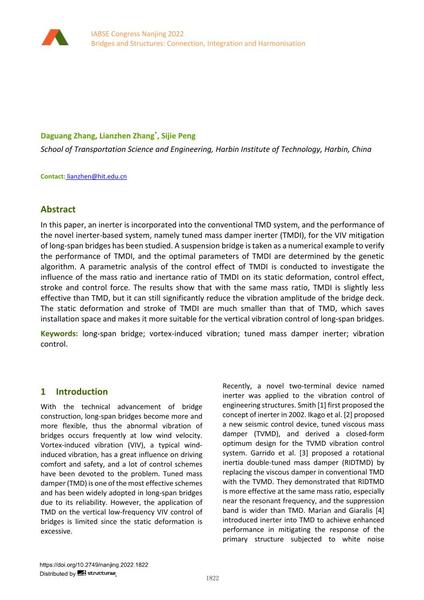Parametric Analysis and Performance Evaluation of Tuned Mass Damper Inerter (TMDI) to Mitigate the Vortex-Induced Vibration of a Long-Span Bridge

|
|
|||||||||||
Détails bibliographiques
| Auteur(s): |
Daguang Zhang
(School of Transportation Science and Engineering, Harbin Institute of Technology, Harbin, China)
Lianzhen Zhang (School of Transportation Science and Engineering, Harbin Institute of Technology, Harbin, China) Sijie Peng (School of Transportation Science and Engineering, Harbin Institute of Technology, Harbin, China) |
||||
|---|---|---|---|---|---|
| Médium: | papier de conférence | ||||
| Langue(s): | anglais | ||||
| Conférence: | IABSE Congress: Bridges and Structures: Connection, Integration and Harmonisation, Nanjing, People's Republic of China, 21-23 September 2022 | ||||
| Publié dans: | IABSE Congress Nanjing 2022 | ||||
|
|||||
| Page(s): | 1822-1830 | ||||
| Nombre total de pages (du PDF): | 9 | ||||
| DOI: | 10.2749/nanjing.2022.1822 | ||||
| Abstrait: |
In this paper, an inerter is incorporated into the conventional TMD system, and the performance of the novel inerter-based system, namely tuned mass damper inerter (TMDI), for the VIV mitigation of long-span bridges has been studied. A suspension bridge is taken as a numerical example to verify the performance of TMDI, and the optimal parameters of TMDI are determined by the genetic algorithm. A parametric analysis of the control effect of TMDI is conducted to investigate the influence of the mass ratio and inertance ratio of TMDI on its static deformation, control effect, stroke and control force. The results show that with the same mass ratio, TMDI is slightly less effective than TMD, but it can still significantly reduce the vibration amplitude of the bridge deck. The static deformation and stroke of TMDI are much smaller than that of TMD, which saves installation space and makes it more suitable for the vertical vibration control of long-span bridges. |
||||
| Copyright: | © 2022 International Association for Bridge and Structural Engineering (IABSE) | ||||
| License: | Cette oeuvre ne peut être utilisée sans la permission de l'auteur ou détenteur des droits. |
||||
